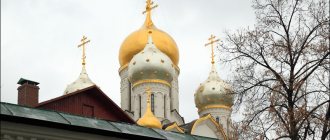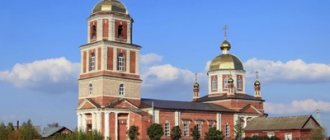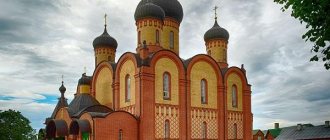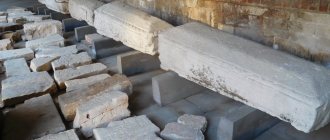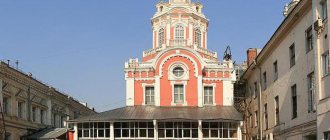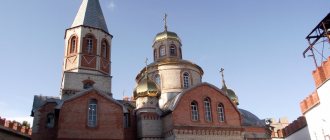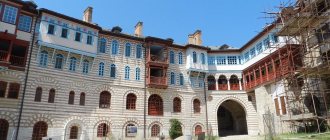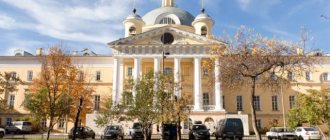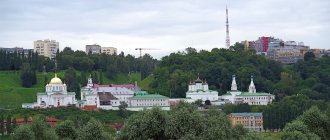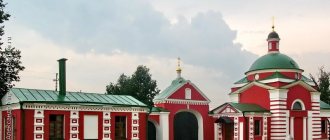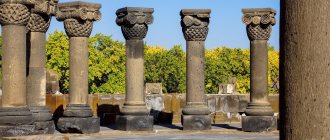The Marfo-Mariinskaya Convent of Mercy is located in the city of Moscow in the historical district of Yakimanka. An oasis of peace, tranquility and silence in a noisy metropolis. It is not only a complex of buildings within the walls of which ministry is carried out to improve people’s lives, but, first of all, the monastery is a collection of people who work for those in need of social or spiritual help.
At the moment, both monastics and sisters of mercy live on the territory. Sisters of mercy mainly participate in social projects, and nuns provide spiritual service. Volunteers and specialists also work in various fields and provide qualified assistance in the social projects of the monastery.
At the moment, there are two more farmsteads, where mainly monastic sisters live. One has been created since 2000 in the Tver region in the village of Vladychnya. The second has been operating since 2002 in the Moscow region, in the village of Kamenki.
© Laskovsky
Schedule of services
The activities of the monastery are aimed at social and spiritual service. On its territory there is the Church of the Intercession of the Blessed Virgin Mary, a chapel, a medical center, an orphanage, a gymnasium, a house-museum, a playground and other facilities.
Services in the Church of the Intercession are held every day. Their schedule is updated weekly on the website.
Schedule of services at the Marfo-Mariinsky Convent
The house-museum of the Reverend Martyr Grand Duchess Elisaveta Feodorovna offers free tours from Tuesday to Sunday from 9:00 to 18:00. To participate, you must pre-register. Tours of the Intercession Cathedral also take place on Sundays, lasting 1 hour.
The operating hours of other services of the monastery can be found on the corresponding websites indicated in the project descriptions.
Wall painting in the Church of the Intercession of the Blessed Virgin Mary, © nikudango
Official website of the Marfo-Mariinskaya Convent
mmom.ru
The complete reconstruction of the monastery was completed in 2008, affecting not only the internal and external decoration of the churches, but also the buildings of the sisters' dormitories, Sunday school, outbuildings and improvement facilities. The founder's chambers were restored and it was decided to open a museum in them. Visitors can still see here unique photographs taken during the life of Elizabeth Feodorovna, her personal belongings, drawings, and correspondence. The guide will tell you about the history of the founding of the monastery, its activities in pre-revolutionary times and today.
Sundays after the end of the Liturgy are reserved for visiting the museum. For visitors in groups on weekdays, excursions are available by appointment. For an individual visit, a sightseeing tour is provided at 11 and 15 hours, it is held daily. Phone numbers, email addresses and details for transferring donations can be found on the monastery website. There you can also find a lot of information about what kind of help the monastery provides, what specialists it needs, and what help you can provide.
There is no hotel at the complex, so non-residents cannot stay on the territory of the monastery. However, there is a cafe inside where visitors can have a snack.
Story
The monastery was founded in 1909 by Grand Duchess Elizabeth Feodorovna. After the tragic death of her husband in 1905, the Moscow Governor-General Grand Duke Sergei Alexandrovich Romanov, the princess decided to devote herself to serving God and her neighbors.
She sold off her personal property and jewelry. She gave one part of the funds received to the treasury, distributed the second to relatives, and with the third she purchased an estate with four houses and a garden. A hospital was set up in one of the houses, and a house church was built in the name of the righteous saints Martha and Mary. These evangelical sisters personify two paths of ministry - the contemplative, prayerful one that Mary chose, and the active one that Martha was engaged in. The princess saw the combination of these paths as the basis for the future Abode.
Initially, it was a special institution, not like a monastery or an ordinary community of sisters of mercy. The nuns of the monastery took monastic vows of chastity, non-covetousness and obedience, however, after a certain period of time, they had the right to leave and start a family.
After opening on February 10, 1909, 6 nuns lived here. By 1918 their number had increased to 105 people. Princess Elizaveta Fedorovna was elevated to the rank of abbess.
Monument to Grand Duchess Elizabeth Feodorovna, © Ludiomila
The main focus of the monastery was the provision of qualified medical care. In addition, there were houses for the poor, a free outpatient clinic with a pharmacy, a work shelter for girls, a Sunday school, a free library, a canteen, and a hotel for pilgrims.
After the Revolution of 1917, the country underwent significant changes. Grand Duchess Elizaveta Feodorovna and her cell attendant nun Varvara (Yakovleva) were martyred on July 18, 1918.
The activities of the monastery aroused respect among the people, so it existed until 1926. After its closure, various interest clubs, a cinema, restoration and other organizations were located here.
In 1990, a monument to Elizabeth Feodorovna, made by sculptor Vyacheslav Klykov, was erected in the courtyard near the Church of the Intercession of the Blessed Virgin Mary. And in 1992, when the territory was transferred to the Moscow Patriarchate, the revival of this fertile corner in the heart of the city began.
Currently, the Marfo-Mariinskaya Convent is considered a convent, while the special way of life established by its founder is preserved here.
Memorial cross to the Alapaevsk martyrs at “Golgotha” (“Golgotha” was the sisters’ name for a small mound in the depths of the garden), © Lodo27
Church of the Intercession of the Blessed Virgin Mary
In 1912, a cathedral church in the name of the Intercession of the Blessed Virgin Mary was built on the territory of the estate. Alexey Viktorovich Shchusev was chosen as the architect. After completion of construction in 1910, wall paintings in the cathedral were carried out by artists M. V. Nesterov, N. Ya. Tamonkin and P. D. Korin.
On the altar apse, Nesterov depicted the “Protection of the Virgin Mary” and the “Liturgy of Angels”. On the northern wall there is the composition “Christ with Martha and Mary”. On the south there is a triptych “The Resurrection of Christ”. And in the refectory - “The Path to Christ.” Also in the church there was an underground tomb, painted by Korin with the plot “The Path of the Righteous to the Lord.” The abbess bequeathed to bury herself in it. The consecration of the cathedral took place on April 8, 1912.
During the Great Patriotic War, the temple served as the headquarters of the Local Air Defense. The area around the church is beautifully landscaped. It is surrounded by well-kept gardens, the area of which is one and a half hectares.
Triptych “The Resurrection of Christ” in the Church of the Intercession of the Blessed Virgin Mary. M. Nesterov. Copper, oil. 1910—1911, © nikudango
How to get there
The territory of the monastery is located on Bolshaya Ordynka Street, 2 km south of the Moscow Kremlin. The monastery can be reached on foot in 10 minutes from the Tretyakovskaya and Polyanka metro stations. The nearest public transport stops are located on Bolshaya Polyanka and Bolshaya Ordynka streets. They can be reached by buses No. 8, M5, M6 and K.
Attraction rating
Rating 4.50 [2 vote(s)]
| ← MONASTERIES OF MOSCOW | MOSCOW → |
Activity
The Convent of Mercy conducts a large number of social projects. The programs are aimed at maintaining the quality of life of the disabled, orphans, as well as the frail elderly and other people who find themselves in difficult life situations. One of the projects is medical rehabilitation. It provides free assistance to children suffering from cerebral palsy, and also operates a children's mobile palliative service and a register. Another area of focus is the Elizabeth Orphanage for Girls, which houses 15 pupils from families in crisis, as well as those with Down syndrome.
Since 2012, the monastery has been working with alcohol-dependent people and their relatives. Those interested can take intensive seven-day courses. The full list of projects can be found on the official website.
There is also a Volunteer Service here. In addition to volunteers, various workers are required from time to time. The site has a special section “Vacancies” for posting advertisements. If you have any questions, you can contact us on weekdays from 9:00 to 17:00, by calling the numbers indicated in the description of each vacancy.
Entrance to the monastery, © SergeyStepykin
Current state
The revival of the monastery began in 1992, when the territory was transferred to the Moscow Patriarchate. Eight years later, the monastery acquired the status of the Patriarchal Metochion. In 2006, headed by the Bishop of Moscow and All Rus' Alexy, the Board of Trustees drew up a plan for the revival of the Marfo-Mariinsky monastery. In the winter of the same year, by decree of the bishop, Abbess Natalya was appointed to the position of abbess. Today, the abbess of the convent is Abbess Elizabeth.
There are two types of sisters in the monastery: some took monastic vows, and the second are sisters of mercy. As a rule, these are lay women who do not bind themselves to the vow of monasticism, but along with “working on the soul,” they also perform other duties and do not drop out of social life.
Today, like a hundred years ago, the monastery operates according to the Charter, which was introduced by Mother Elizabeth. The sisters study medicine at the St. Demetrius School, work in hospitals and clinics, and take care of the affairs of the monastery. Just like under the princess, the monastery has a shelter for orphans, a guardianship service, a free canteen, an educational center and a gymnasium.
In addition, a center for children with cerebral palsy was opened at the monastery. A twenty-day course was developed especially for such children. Comprehensive rehabilitation includes sessions with a neurologist, osteopath, orthopedist, speech pathologist, physiotherapist and psychologist. The goal of the course is to completely rid the patient of convulsive syndromes and seizures.
Association of Sisterhoods
The need to create a structure is due to the large number of sisterhoods in different parts of the world with different numbers of participants and different areas of activity. There is a need to streamline their activities. The association was created in 2010. The Chairman of the Association is Panteleimon, Bishop of Orekhovo-Zuevsky.
Goals and objectives
The structure was created to unite sisters of mercy and exchange useful experience in participating in social projects. It is expected that this will contribute to the creation of an international organization of sisterhoods, the formation of a Unified Database of the organization and the coordination of social programs.
Activity
According to the stated goals and objectives, since 2011, the Association has carried out a number of events, achieving positive experience in a variety of areas. Sisters and confessors from dioceses near and far abroad take part annually.
